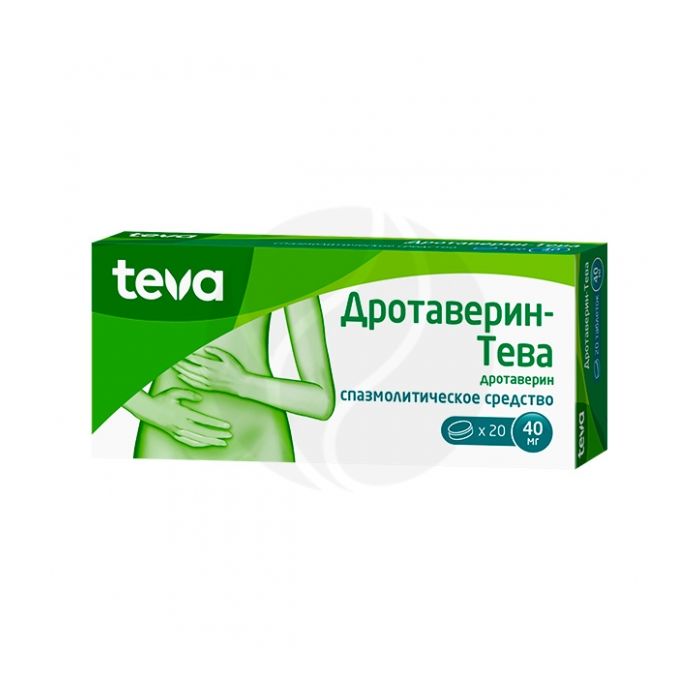Drotaverin-Teva tablets 40mg, No. 20
Expiration Date: 05/2027
Russian Pharmacy name:
Дротаверин-Тева таблетки 40мг, №20
Spasms of smooth muscles associated with diseases of the liver and biliary tract: cholelithiasis, cholecystitis, pericholecystitis, cholangitis, papillitis;
spasms of smooth muscles of the urinary system: urolithiasis, pyelitis, cystitis, tenesmus of the bladder.
As an auxiliary therapy: spasms of smooth muscles of the gastrointestinal tract: gastric ulcer and duodenal ulcer, gastritis, spasms of the cardia and pylorus, enteritis, colitis, accompanied by constipation and flatulence; tensor headache; dysmenorrhea
Inside with a sufficient amount of liquid.
The recommended daily dose for adults is 120-240 mg (2-3 divided doses).
For children aged 6 to 12 years, the maximum daily dose is 80 mg, divided into 2 doses;
for children over 12 years of age, the maximum daily dose is 160 mg, divided into 2-4 doses. The recommended duration of treatment without consulting a doctor is 1-2 days.
1 tablet contains:
active substance drotaverine hydrochloride 40.00 mg;
excipients: lactose monohydrate 67.00 mg; povidone-K25 4.00 mg; microcrystalline cellulose 21.00 mg; croscarmellose sodium 5.00 mg; magnesium stearate 3.00 mg.
Hypersensitivity to drotaverine or to any of the components of the drug;
severe renal failure;
severe hepatic impairment (class C on the Child-Pugh scale);
severe heart failure (low cardiac output syndrome);
children under 6 years of age;
breastfeeding period;
lactose intolerance, lactase deficiency, glucose-galactose malabsorption syndrome.
Carefully
Pregnancy, arterial hypotension, simultaneous use with levodopa.
Pharmacodynamics
Drotaverine is an isoquinoline derivative that exhibits an antispasmodic effect on smooth muscles by inhibiting the enzyme phosphodiesterase 4 (PDE-4). Inhibition of the enzyme PDE-4 leads to an increase in the concentration of cyclic adenosine monophosphate (cAMP), which inactivates the light chain myosin kinase (MLCK), which, in turn, leads to relaxation of smooth muscles. Drotaverine inhibits the PDE-4 enzyme in vitro without inhibiting the isoenzymes PDE-3 and PDE-5. Apparently, PDE-4 is functionally very important for reducing the contractility of smooth muscles; therefore, selective PDE-4 inhibitors can be effective in the treatment of hyperkinetic diseases and diseases associated with spastic conditions of the gastrointestinal tract (GIT). An enzyme that hydrolyzes cAMP in myocardial and vascular smooth muscle cells,is mainly an isoenzyme of PDE-3, which explains the high efficiency of drotaverine as an antispasmodic in the absence of a pronounced effect on the cardiovascular system and serious cardiovascular adverse reactions. Drotaverine is effective for smooth muscle spasms of both nervous and muscular etiology. Regardless of the type of autonomic innervation, drotaverine acts on the smooth muscles of the gastrointestinal tract, biliary tract, as well as the genitourinary and vascular systems. Due to the vasodilating effect, drotaverine improves tissue blood supply.Regardless of the type of autonomic innervation, drotaverine acts on the smooth muscles of the gastrointestinal tract, biliary tract, as well as the genitourinary and vascular systems. Due to the vasodilating effect, drotaverine improves tissue blood supply.Regardless of the type of autonomic innervation, drotaverine acts on the smooth muscles of the gastrointestinal tract, biliary tract, as well as the genitourinary and vascular systems. Due to the vasodilating effect, drotaverine improves tissue blood supply.
Pharmokinetics
Absorption and distribution
When taken orally and parenterally, drotaverine is rapidly and completely absorbed. The maximum plasma concentration (Cmax) is reached within 45-60 minutes. Binds to plasma proteins (alpha albumin, alpha and beta globulins). Metabolism and excretion Metabolized in the liver. The half-life (T1 / 2) is 16-22 hours. After 72 hours, drotaverine is excreted from the body mainly in the form of metabolites, 50% - by the kidneys, 30% - through the intestines.
Overdose
There are no data on overdose with Drotaverin-Teva. Overdose symptoms can be cardiac arrhythmias and conduction disturbances (including complete blockade of the bundle of His bundle), cardiac arrest, and even death. Treatment: gastric lavage, symptomatic therapy.
Side effects
Side effects are classified according to the following frequency: very often - at least 10%; often - not less than 1%, but less than 10%; infrequently - not less than 0.1%, but less than 1%; rarely - not less than 0.01%, but less than 0.1%; very rarely (including individual messages) - less than 0.01%; frequency unknown - insufficient data to estimate the frequency of the event in the population.
From the gastrointestinal tract: rarely - nausea, constipation.
From the side of the central nervous system: rarely - headache, dizziness, insomnia.
From the side of the cardiovascular system: rarely - heart palpitations; very rarely - a decrease in blood pressure.
Special conditions
Caution should be exercised when using the drug Drotaverin-Teva in patients with arterial hypotension. The tablets contain lactose, therefore, Drotaverin-Teva is not prescribed for patients with lactose intolerance, lactase deficiency, glucose-galactose malabsorption syndrome.
Influence on the ability to drive vehicles, mechanisms
When taken orally in therapeutic doses, drotaverine does not affect the ability to drive vehicles and perform work that requires increased concentration of attention. If any adverse reactions manifest, the question of driving a vehicle and working with mechanisms requires individual consideration. In case of dizziness after taking the drug, the patient should avoid engaging in potentially hazardous activities, such as driving and working with machinery.
Drug interactions
With levodopa
With simultaneous use, it can weaken the antiparkinsonian effect of levodopa, that is, increase rigidity and tremor.
With papaverine, bendazole and other antispasmodics (including M-anticholinergics) Strengthening the antispasmodic effect.
With morphine
Reducing the spasmogenic activity of morphine.
With phenobarbital
Strengthening the antispasmodic effect of drotaverine.

